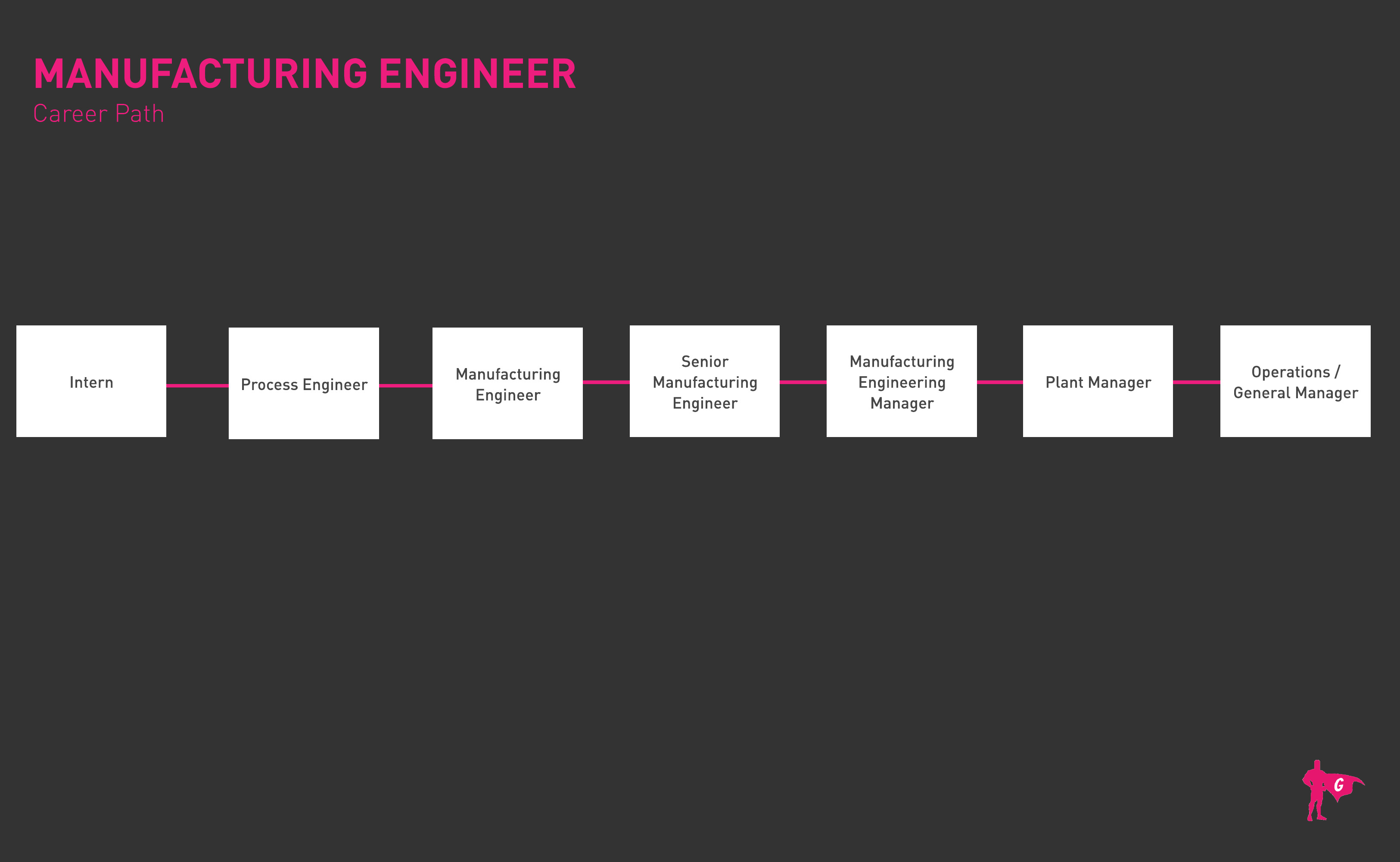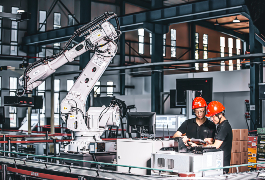스포트라이트
시설 엔지니어, 제조 엔지니어, 플랜트 엔지니어, 프로세스 엔지니어, 프로세스 개선 엔지니어
수작업으로 제작되지 않은 제품이라면 어딘가의 공장에서 제조되었을 가능성이 높습니다. 제품 제조는 여러 작업자가 참여하는 매우 복잡하면서도 잘 조직된 프로세스입니다. 가장 중요한 공장 직원 중에는 제조 엔지니어가 있습니다. 제조 엔지니어는 생산 라인을 원활하고 안전하게 운영하여 최대한 비용 효율적으로 제품을 생산할 수 있도록 하는 다재다능한 전문가입니다.
제조 엔지니어는 "컴퓨터 네트워크, 로봇, 공작 기계, 자재 취급 장비"와 같은 다양한 제조 시스템을 담당할 수 있습니다. 제조 엔지니어는 작업에 필요한 작업자 수, 작업 단계, 필요한 기술, 전체 비용 등을 고려하여 생산 공정에서 낭비되는 부분을 줄일 수 있는 방법을 모색하기 때문에 작업장 안전은 제조 엔지니어의 주요 관심사입니다. 또한 제품이 사양을 충족하고 매장이나 창고로 배송되어 구매를 기다릴 준비가 되었는지 확인하기 위해 품질 보증 프로세스를 감독할 수도 있습니다.
- 상업 및 산업 디자이너와 협업하여 제품 개선하기
- 공동의 목표를 향해 다양한 팀과 협력
- 직장 내 위험으로부터 직원을 안전하게 보호하도록 지원
- 생산 효율성 극대화를 통한 고용주의 비용 절감
- 소비자에게 출시할 흥미로운 신개념 제품 및 컨셉 개발
- 아이디어를 유형의 상품으로 전환
- 위험한 작업을 수행할 수 있는 기술을 개선하여 사람이 할 필요가 없도록 합니다.
근무 일정
- 대부분의 제조 엔지니어는 풀타임으로 근무하며, 성수기나 생산이 예정보다 늦어지거나 주문이 예상치를 초과하는 경우 초과 근무를 할 수 있습니다.
- 일반적인 의무
- 고객과 만나 원하는 제품의 사양에 대해 논의하세요.
- 공급업체 및 경영진과 기능 상태, 일정, 제한 사항, 가능한 문제 해결 방안에 대해 논의하세요.
- 사양에 따라 특정 부품 또는 제품을 제조하는 데 적합한 도구, 기계, 장비 및 프로세스를 결정합니다.
- 유해한 관행과 자료를 줄이거나 제거할 방법을 모색합니다.
- 일정과 워크플로를 검토하여 올바른 수의 작업자가 배정되었는지 확인합니다.
- 관리 제어 시스템을 사용하여 팀의 노력을 체계화하세요
- 품질 보증 프로토콜을 수립하여 제품이 표준에 맞게 제작되도록 보장합니다.
- 린 제조 원칙을 사용하여 생산 속도를 지속적으로 평가하고 효율성을 개선하고 비용을 절감할 수 있는 방법을 모색합니다.
- 프로덕션 팀과 협업하여 제시간에, 목표에, 예산에 맞게 작업을 진행하세요.
- 워크플로우를 분석하여 병목 현상과 같은 잠재적인 문제를 검색하고 완화하세요.
- 지연이나 업무 중단을 초래할 수 있는 예기치 못한 문제를 해결하기 위한 백업 계획을 수립하세요.
- 설계, 재료 및 프로세스 테스트 및 문제 해결
- 필요에 따라 기술 지원 또는 교육 제공
- 직원들과 정기적으로 확인하여 프로젝트가 어떻게 진행되고 있는지 확인하세요. 필요에 따라 감독
- 프로덕션 장애의 근본 원인을 조사하고 수정 또는 조정을 제안하세요.
- 제조 성과에 대한 보고서 생성
- 지속 가능한 프로세스와 관련된 재무 요소를 검토하고 경영진에게 제안을 제공합니다.
- 비용 효율적인 운송 관행을 유지하면서 고객에게 상품을 적시에 배송할 수 있습니다.
추가 책임
- 작업 공간 및 장비 레이아웃을 설계하고 설치를 감독합니다.
- 필요에 따라 장비, 부품 및 각종 자재 조달
- 다양한 업무 프로세스에 대한 문서 작성
- 제조 및 조립 프로세스 개선에 대한 최신 정보 확인
- 툴링 및 장비의 트렌드와 기술 발전에 대해 알아보고 가능한 경우 이를 통합하세요.
- 주, 연방 및 국제 코드 및 표준 준수 보장
- 평생 교육 및 전문가 단체 이벤트 참여
소프트 스킬
- 개념화 능력
- 팀 간의 공동 작업을 촉진하는 기능
- 적응형 스타일
- 분석
- 예산에 민감한 고객
- 압박감 속에서 진정
- 규정 준수 및 안전 지향
- 집중력과 집중력
- 좋은 기록 관리 기술
- 이니셔티브
- 혁신적인
- 조사의
- 지도력
- 조직
- 끈기
- 문제 해결
- 사실적인
- 강력한 사람과 의사 소통 기술
- 팀워크
- 시간 관리
기술 능력
- 오토데스크 오토캐드와 같은 컴퓨터 지원 설계(CAD) 도구
- 조립 라인 프로세스에 대한 지식
- 솔리드웍스 지식
- 린 제조
- 프로세스 개선
- 품질 보증 원칙
- 근본 원인 분석
- 식스 시그마
- 문제 해결 전략
- 기계 공학에 대한 이해
- 자동차 산업; 운송 장비 제조
- 컴퓨터/전자 제품 제조업체
- 제조 회사
- 군사 및 정부 기관
제조 엔지니어는 공장 생산이 원활하게 이루어지도록 유지하지만, 이를 위해 해야 할 일과 계획이 엄청나게 많습니다. 올바른 기술을 가진 노동자를 선택하고 최고의 도구, 장비, 기계를 선택하는 것부터 작업 공간을 배치하고 절차를 수립하는 것까지 제조 엔지니어는 할 일이 많습니다!
기업은 생산 흐름과 비용 절감, 근로자의 안전을 유지하기 위해 엔지니어의 재능에 크게 의존합니다. 한 번의 잘못된 결정이나 감독으로 인해 결함 있는 제품부터 안전 리콜 및 전체 작업 중단에 이르기까지 막대한 비용이 발생하는 제조 문제가 발생할 수 있습니다. 심각하게 안전하지 않은 제품이 시장에 출시되면 기업의 평판이 나빠지고 재정적 파탄으로 이어질 수 있습니다. 치토스의 재앙적인 립밤 제품 실패와 같이 콘셉트 단계부터 폐기했어야 할 제품이 출시되는 경우도 있습니다.
제조 엔지니어의 직업 전망은 매우 밝은데, 이는 부분적으로는 제조 엔지니어가 가져다주는 비용 절감 효과 때문입니다. 제조 엔지니어의 주요 업무는 트렌드와 혁신을 파악하는 것이며, 요즘에는 여러 가지 혁신이 있습니다.
자동화는 오랫동안 많은 공장의 핵심 목표였으며, 점점 더 널리 보급되고 사용하기 쉬워지고 있습니다. 모바일 로봇과 협업 로봇도 제조 환경을 변화시킬 준비가 되어 있으며, 흥미진진한 새로운 기능을 선보이고 있습니다. 한편, 전설적인 사물 인터넷은 계속 발전하여 기업이 프로세스를 최적화하는 데 사용할 수 있는 귀중한 데이터를 수집할 수 있도록 지원하고 있습니다.
4차 산업혁명으로 불리는 인더스트리 4.0은 "초고속 모바일 인터넷, AI 및 자동화, 빅데이터 분석, 클라우드 기술"에 기반한 여러 이니셔티브를 통해 그 기대에 부응하고 있습니다. 또 다른 트렌드로는 새로운 것은 아니지만 클라우드 기반 SaaS 덕분에 배포가 더 간편해진 전사적 자원 관리의 확산이 있습니다.
제조 엔지니어는 매우 체계적이고 프로세스 지향적입니다. 복잡한 레고 세트를 조립하는 등 여러 단계를 정확한 순서대로 수행해야 하는 세심한 활동을 즐겼을 수도 있습니다. 비효율적인 요소를 없애는 데 관심이 많으며, 집안일이나 숙제를 다른 사람보다 더 빨리 끝낼 수 있는 방법을 찾았을 수도 있습니다. 대부분의 엔지니어와 마찬가지로, 이들은 창의적인 사고와 손재주를 통해 추상적인 아이디어를 구체적인 현실로 바꾸는 방법을 찾는 것을 좋아합니다.
AI와 로봇 공학을 비롯한 첨단 기술에 몰두하는 경우가 많기 때문에 어렸을 때 공상 과학 소설의 열렬한 팬이었을 수도 있습니다. 또한 제조 엔지니어는 많은 사람과 그룹의 업무를 감독해야 하기 때문에 일반적으로 학교 과외 활동을 통해 또는 대가족 속에서 자라면서 쌓은 소프트 스킬이 잘 발달되어 있을 가능성이 높습니다.
- 제조 엔지니어의 70%는 학사 학위를, 16%는 석사 학위를 보유하고 있습니다. 많은 대학 프로그램에서 약 5년이 소요되는 학사/석사 복수 학위 트랙을 제공합니다.
- 대부분 산업 공학, 제조 공학 또는 기계 공학 전공자
- 엔지니어링 프로그램은 ABET의 인증을 받아야 합니다.
- 석사 과정은 종종 R & D에서 가르치거나 일하기 위해 필요합니다.
- 인턴십, 협동 조합 및 기타 실제 업무 경험은 고용주가 소중히 여깁니다.
- 시작하기 위해 라이선스가 필요하지는 않지만, 전문 엔지니어링(PE) 라이선스를 취득하면 승진 기회로 이어질 수 있습니다.
- PE는 다음 두 가지 시험을 통과해야 합니다.
- 공학의 기초 (FE)
- 공학의 원리와 실습 (PE) 시험
- PE는 다음 두 가지 시험을 통과해야 합니다.
- 다음과 같은 몇 가지 선택적 인증을 고려할 수 있습니다:
- 미국 품질 협회 - 식스 시그마 옐로우 벨트 인증
- American Society of Mechanical Engineers International - Geometric Dimensioning & Tolerancing Professional - Technologist
- 오토데스크 -
- Autodesk Moldflow Insight 전문가 인증
- Autodesk Moldflow 인사이트 어소시에이트 인증
- 국제 식스 시그마 인증 협회 - 다양한 색상의 벨트
- 포장 기계 제조 연구소 - 메카트로닉스 인증 테스트 - 모터 및 모터 컨트롤
- SAP America- 공인 애플리케이션 어소시에이트 - SAP S/4HANA 클라우드(퍼블릭) - 제조 구현
- 유지보수 및 신뢰성 전문가 협회 - 인증된 유지보수 및 신뢰성
- 제조 엔지니어 협회 - 학회
- 린 실버 인증
- 식스 시그마 그린 벨트 인증
- 공인 제조 엔지니어
- 식스 시그마 마스터 블랙 벨트 인증
- 린 골드 인증
- 프로그램은 ABET 인증을 받아야하며, 이는 나중에 PE 면허를 취득하기위한 요구 사항입니다.
- 장학금과 STEM 진로를 찾아 시간과 비용을 절약하세요.
- 프로그램의 교수진 수상 경력 및 업적을 고려하세요. 교육상, IEEE 및 국립과학재단 상 및 표창, 풀브라이트 펠로우십, 최우수 논문, 저명한 강사 등 권위 있는 영예를 누릴 수 있습니다.
- 특히 직접 참석할 계획이라면 시설을 확인해 보세요. 자금이 잘 지원되는 프로그램은 가장 현대적인 최첨단 연구 분야를 갖추고 있습니다.
- 제휴 센터 및 연구소를 찾으십시오. 대부분의 큰 프로그램은 학습 경험을 크게 향상시킬 수있는 외부 파트너와 협력합니다.
- 학교가 졸업생에게 어떤 혜택이나 리소스를 제공하는지 항상 확인하세요. 면접 준비에 도움을 주거나 지역 업계와 긴밀한 관계를 맺고 있나요? 동문 네트워크에서 경력 향상에 도움이 되는 멘토링과 네트워킹을 제공하나요?
- 고등학교에서 수학, 물리학, 공학, 기술 등 대학 진학 준비 수업을 들으면 대학 진학에 유리합니다. 강력한 영어 및 기술 문서 작성 능력도 나중에 도움이 됩니다.
- 자동차, 상업용 제품, 컴퓨터 등 어떤 유형의 제조업에 참여하고 싶은지 결정합니다.
- 수업에 등록하기 전에 해당 직업 분야에 대해 가능한 모든 것을 알아보세요. 취업 포털에 게시된 직무 설명을 읽고 미리 정찰하세요.
- 근무하고 싶은 조직의 목록을 작성하고, 현직 직원에게 연락하여 조언을 구할 수도 있습니다.
- 미국에 본사를 둔 주요 제조 기업으로는 포드, 제너럴 모터스, 델, 존슨 앤 존슨, 제너럴 일렉트릭, 인텔, IBM, 프록터 앤 갬블, 펩시코, 록히드 마틴, 보잉, 휴렛팩커드, 레이시온이 있습니다.
- 인턴십 또는 수습직을 통해 실무 경험 쌓기
- 부드러운 기술을 소홀히하지 마십시오. 엔지니어도 "사람"이어야합니다!
- 학교위원회에서 봉사하거나 과외 활동을 돕기 위해 자원 봉사하며 리더십과 경영 경험을 제공하는 역할에 중점을 둡니다.
- 아래의 추천 웹사이트 목록을 살펴보고 가입할 전문가 그룹을 찾아보세요.
- 학교의 엔지니어링 클럽에 적극적으로 참여하기
- 숙련된 제조 엔지니어에게 정보 제공 인터뷰에 응할 의향이 있는지 물어보세요.

- 대졸자는 공장이나 물류창고에서 근무하는 초급 제조 엔지니어 직책에 지원해야 합니다.
- 1~2년의 관련 업무 경험이 있으면 지원 시 경쟁력을 높이는 데 도움이 됩니다.
- 인턴십은 실무 경험을 쌓을 수 있는 좋은 기회일 뿐만 아니라 때로는 정규직으로 이어질 수도 있습니다!
- 근무 가능 시간에 대해 유연하게 대처하세요. 신입사원에게 야간 또는 주말 근무를 배정할 수 있습니다.
- Indeed, SimplyHired, Monster, USAJobs, ZipRecruiter, LinkedIn, Velvet Jobs 및 Glassdoor와 같은 취업 포털에서 알림을 신청하십시오.
- 네트워크의 모든 사람에게 채용 정보를 물어보세요. 페이스케일에 따르면, 85%의 일자리가 네트워킹을 통해 발견됩니다!
- 학교의 커리어 센터에 이력서 작성, 모의 면접, 채용 담당자와의 연결에 대한 도움을 요청하세요.
- 회사에 대한 숙제를 하고 매번 특정 채용 공고에 맞춰 이력서를 작성하세요.
- 제조 엔지니어 이력서 템플릿 및 일반적인 면접 질문 검토하기
- 소규모 회사에서는 나중에 원하는 승진 기회가 없을 수도 있지만, 경험이 적은 사람을 고용할 가능성이 더 높다는 점을 명심하세요.
- 업무를 처리하고, 프로세스를 원활하게 하고, 비용을 절감하고, 작업자의 생산성과 안전을 유지하는 분야별 전문가가 되세요.
- 장기적인 목표를 세우고, 마일스톤을 설정하고, 달성 방법을 전략적으로 계획하세요.
- 업무 경험이 충분하다면 전문 자격증에 도전하세요.
- 전문 엔지니어 자격증을 취득하여 탁월함을 향한 노력과 더 큰 책임에 도전하고 싶다는 열망을 보여주세요.
- 고용주와 솔직한 대화를 통해 커리어 목표에 대해 논의하세요. 적절한 시기에 승진 기회에 대해 물어보고, 고용주가 여러분에게 투자한 시간과 노력을 염두에 둡니다.
- 꿈을 포기하지 않고 유연성을 유지하세요. 가까운 시일 내에 사내 승진이 가능하다면 다른 회사로 이직하는 것보다 기다리는 것이 더 나을 수 있습니다.
- 더 높은 급여와 개인적으로 보람 있는 일 중 어떤 것이 더 중요한지 결정하세요. 두 마리 토끼를 모두 잡을 수 있다면 더할 나위 없이 좋겠죠!
- 소규모 회사에서 근무하는 경우 다른 곳에 지원하지 않는 한 선택의 폭이 영구적으로 제한될 수 있지만, 승진이 어렵다면 최소한 승급을 요청하고 그 이유를 정당화하세요.
웹사이트
- 엔지니어링 및 기술 인증위원회
- 미국 공학 교육 학회
- 미국 기계 공학회
- 엔지니어링 교육 서비스 센터
- 산업 및 시스템 엔지니어 협회
- 엔지니어링 및 측량을위한 전국 심사관 협의회
- 국립 전문 엔지니어 협회
- 제조 엔지니어 협회
- 여성 엔지니어 협회
- 기술 학생 협회
책
- 현대 제조의 기초: 재료, 프로세스 및 시스템, Mikell P. Groover 저
- 제조 엔지니어링 및 기술, Serope Kalpakjian, 스티븐 슈미드 작성
- 제조 엔지니어링 핸드북, 화위 겅(Hwaiyu Geng) 저
엔지니어링에는 여러 분야와 하위 분야가 있으며, 선택할 수 있는 경력 경로도 수백 가지에 이릅니다. 제조 엔지니어링이 마음에 들지 않는다면 다음과 같은 몇 가지 엔지니어링 관련 직업을 고려해 볼 수 있습니다:
- 항공우주 엔지니어
- 건축 및 엔지니어링 관리자
- 생물 의학 엔지니어
- 컴퓨터 하드웨어 엔지니어
- 전기 및 전자 공학 기술자
- 물류 엔지니어
- 기계 엔지니어
- 네트워크 및 컴퓨터 시스템 관리자
- 포토닉스 엔지니어
- 영업 엔지니어
꼭 공학도의 길을 걷고 싶지 않은 사람들을 위해 제조 엔지니어링과 관련된 직종도 있습니다:
- 비용 추정기
- 산업 생산 관리자
- 물류학자
- 관리 분석가
- 산업 보건 및 안전 전문가 및 기술자
- 품질 관리 검사관
뉴스 피드

주요 채용 정보

온라인 과정 및 도구







